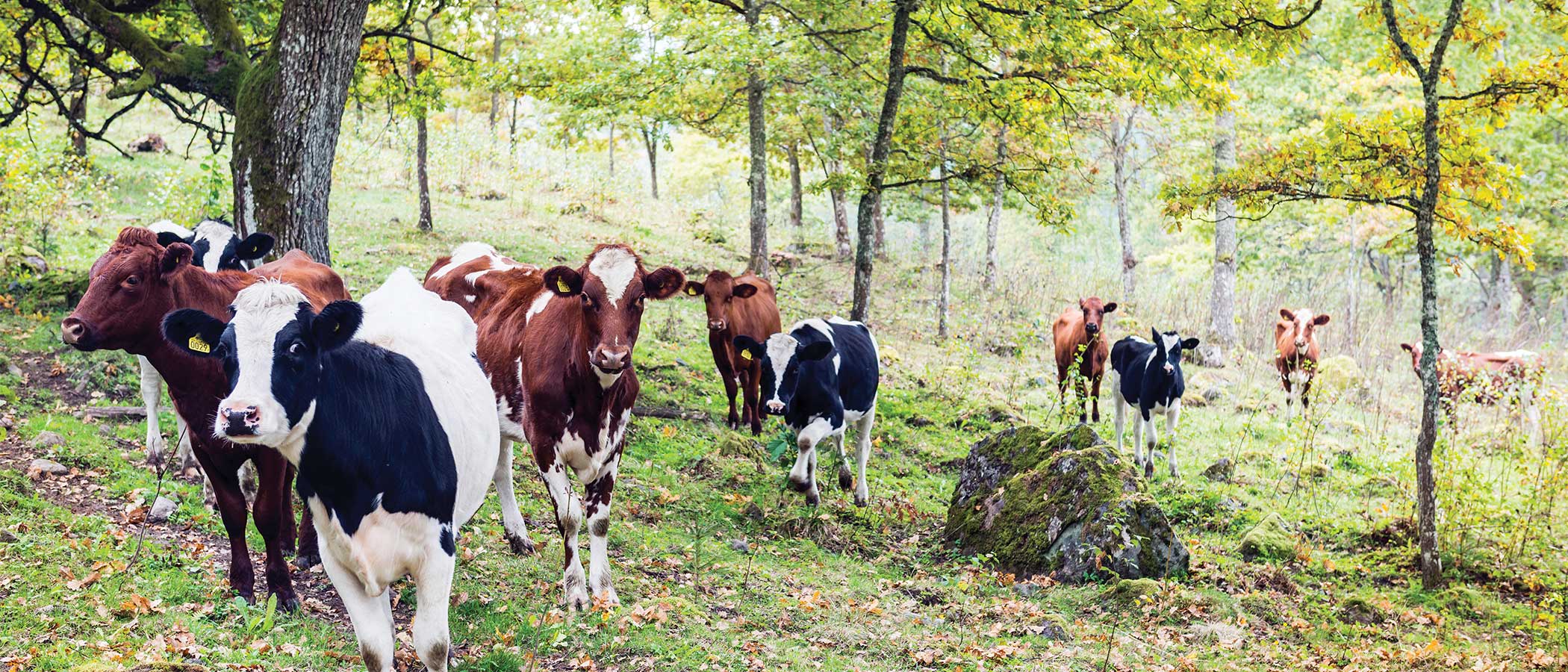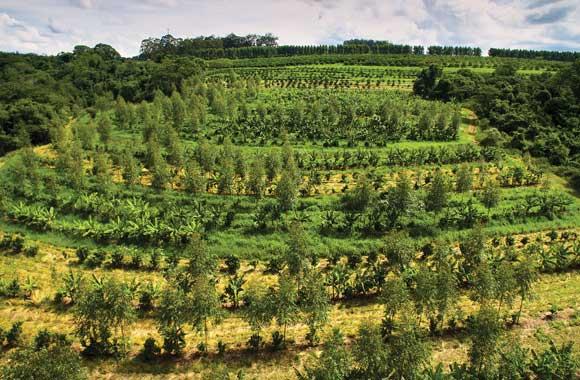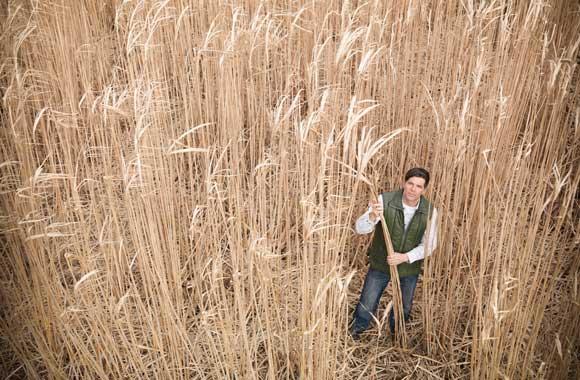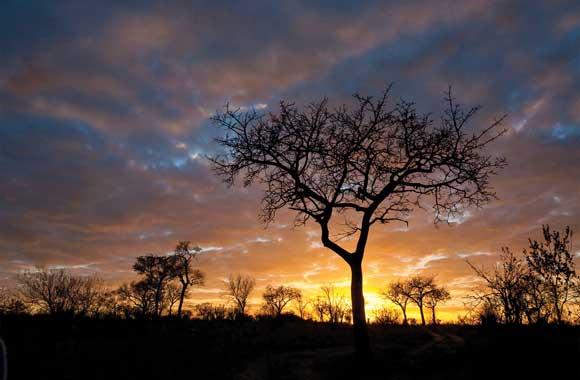Silvopasture
Silvopasture integrates trees, pasture, and forage into a single system. Incorporating trees into agriculture improves land health and increases carbon sequestration.
Reduced/Sequestered
2020–2050
To Implement
Operational Savings
Impact
We estimate that silvopasture is currently practiced on 550 million hectares. If adoption expands to 720.55–772.25 million hectares by 2050—out of the 823 million hectares theoretically suitable for silvopasture—carbon dioxide emissions can be reduced by 26.58–42.31 gigatons, thanks to the high annual carbon sequestration rate of 2.74 metric tons of carbon per hectare per year in soil and biomass. Farmers could realize financial gains from revenue diversification of US$1.75–2.36 trillion on an investment of US$206.75–272.91 billion with a lifetime net operational cost of US$2.33–3.12 trillion.
Introduction
Silvopasture is an ancient practice that integrates trees and pasture into a single system for raising livestock. Pastures with trees sequester five to 10 times as much carbon as those of the same size that are treeless while maintaining or increasing productivity and providing a suite of additional benefits. Livestock continue to emit the greenhouse gases methane and nitrous oxide, but these are more than offset by carbon sequestration, at least until soil carbon saturation is achieved.
Silvopasture also offer financial benefits for farmers and ranchers. Livestock, trees, and other forest products, such as nuts, fruit, and mushrooms, generate income on different time horizons. And help protect farmers from risk. The health and productivity of both animals and the land improve.
Project Drawdown’s Silvopasture solution involves adding trees to pastures for increased productivity and biosequestration. It replaces conventional livestock grazing on pasture and rangeland.
Silvopasture often runs counter to farming norms and can be costly and slow to implement. Peer-to-peer education has proven effective for spreading it. As the impacts of global warming progress, appeal will likely grow, because silvopasture can help farmers and their livestock adapt to erratic weather and increased drought.
Methodology
Total Land Area
To evaluate the extent to which a Food, Agriculture, and Land Use sector solution can reduce greenhouse gas emissions and sequester carbon, we need to identify the total land area available for that solution. To avoid double counting, we use an integration model that allocates land area among all of the sector’s solutions. This involves two steps. First, we classify the global land area into agro-ecological zones (AEZs) based on the land cover, soil quality, and slope and assign AEZs to different thermal moisture regimes. We then classify the AEZs into “degraded” and “nondegraded.” Second, we allocate the solutions to AEZs, with the solution most suited to a given AEZ or sets of AEZs assigned first, followed by the second-most-suited solution, and so on. Because it’s hard to predict future changes, we assume the total land area remains constant. Total land areas represent both the implementation and functional unit.
We calculated total land available for the Silvopasture solution at 823 million hectares, consisting of nondegraded grassland with minimal or moderate slopes in humid climates. Current adoption (the amount of functional demand supplied by the solution in 2014) was an estimated 550 million hectares, based on Lal et al. (2018).
Adoption Scenarios
Because historical growth data and future projections are limited, we based future adoption of the Silvopasture solution on linear projections of current data documenting areas under silvopasture, grazing, and pasture. We developed seven custom adoption scenarios based on a) areas with more than 30 percent tree cover as determined by Zomer et al. (2014), b) estimates of historic adoption rates reported by Nair (2012) and Lal et al. (2018), c) a meta-analysis estimating current area of grazing or pasture land already under silvopasture practice, and d) a meta-analysis estimating current area of grazing or pasture land under improved pasture.
We calculated impacts of increased adoption of the Silvopasture solution from 2020 to 2050 by comparing two scenarios with a reference scenario in which the market share was fixed at current levels.
- Scenario 1: 720.55 million hectares are adopted by 2050 (88 percent of total available land area).
- Scenario 2: 772.25 million hectares are adopted by 2050 (94 percent of total available land area).
Emissions, Sequestration, and Yield Model
We set sequestration rates for silvopasture at 2.7 metric tons of carbon per hectare per year, based on meta-analysis of 14 data points from eight sources. We set yield gains compared with business-as-usual annual grazing at 11.1 percent, based on meta-analysis of six data points from two sources.
Financial Model
All monetary values are presented in 2014 US$.
We estimated the net first cost of adopting silvopasture at US$1,180.65 per hectare based on a meta-analysis of 20 data points from 10 sources. We assume there is no first cost for conventional grazing because it is already in place on the land. We calculated a net profit of US$840.25 per hectare per year for the solution (based on meta-analysis of 17 data points from 11 sources), compared with US$154.12 per year for the conventional practice (based on 20 data points from 15 sources).
We estimated annual operational cost for silvopasture to be US$761.57 per hectare (based on meta-analysis of 17 data points from 12 sources), compared with US$328.42 for the conventional practice (based on nine data points from seven sources).
Integration
Project Drawdown’s Agro-Ecological Zone model allocates current and projected adoption of solutions to the planet’s forest, grassland, rain-fed cropland, and irrigated cropland areas. We limited adoption of silvopasture to nondegraded grassland with minimal or moderate slopes, and made it the highest priority for these lands. Most grassland is likely too dry to support tree growth, so this study is somewhat conservative in its adoption projections.
Results
Scenario 1 saves 26.58 gigatons of carbon dioxide equivalent emissions by 2050. The net first cost to implement is US$206.75 billion, and the lifetime net operational cost is US$2.33 trillion. The lifetime net profit is US$1.75 trillion.
Scenario 2 saves 42.31 gigatons of carbon dioxide equivalent emissions by 2050. The net first cost to implement is US$272.91 billion, and the lifetime net operational cost is US$3.12 trillion. The lifetime net profit is US$2.36 trillion. Global livestock yield increases 1.2 million metric tons from 2020 to 2050.
Discussion
Benchmarks
Lal et al. (2018) estimate a range of 0.55–1.90 for the technical potential of carbon sequestration by silvopastures. The annual impact of silvopasture in 2030 of 0.55–1.07 gigatons of carbon dioxide equivalent per year is closely in line with Lal et al.’s 2018 benchmark.
Limitations
This analysis could be improved with additional data points on financials. Better data on current and projected adoption would be of use as well, as would projections of mitigation impact. More research on the suitable area of global grassland, with sufficient rainfall to permit tree growth, is also essential to precisely determine the potential impact of this solution.
Conclusions
Silvopasture is the highest ranked of all of Project Drawdown's agricultural solutions in terms of mitigation impact, though it has received little attention. It should be a priority for scaling up wherever grasslands are humid enough to permit tree growth. This is particularly important given the need to produce climate-friendly livestock products to meet global demand for meat and dairy, even with our plant-based diet and reduced food waste projections.
Climate mitigation literature often lumps silvopasture into an undifferentiated “agroforestry” category with multistrata agroforestry and tree intercropping. Silvopasture’s high sequestration rates and increased meat and dairy yields make it worthy of consideration on its own. Though managed grazing has been the focus of much attention for its climate mitigation potential, this study demonstrates that silvopasture is also worthy of attention. In fact, it is shown to have a substantially higher mitigation impact than managed grazing. Thus, silvopasture is an essential supply-side food solution in any mitigation program.
References
Lal, R., Smith, P., Jungkunst, H. F., Mitsch, W. J., Lehmann, J., Nair, P. R., ... & Skorupa, A. L. (2018). The carbon sequestration potential of terrestrial ecosystems. Journal of Soil and Water Conservation, 73(6), 145A-152A.
Nair (2012). Climate Change Mitigation: A Low-Hanging Fruit of Agroforestry. In Agroforestry - The Future of Global Land Use, Nair, and D. Garrity, eds. (Dordrecht: Springer Netherlands), pp. 31–67.
Zomer, R., Trabucco A, Coe, R., Place, F., van Noordwijk, M., and Xu, J. (2014). Trees on farms: an update and reanalysis of agroforestry’s global extent and socio-ecological characteristics (World Agroforestry Centre (ICRAF)).
What You Can Do
If you farm, consider adding tree crops. such as nuts and fruit, to your enterprise.
Support farms that use silvopasture and other systems that sequester carbon as well as produce food.
- Expand your knowledge by exploring another Drawdown solution.
Co-benefits
Silvopasture improves soil water retention by increasing organic matter in soil which acts as a buffer during droughts.
It increases farmer income through diversification of trees and crops.
It contributes to animal well-being by increasing shade and protecting them from heat stress.











